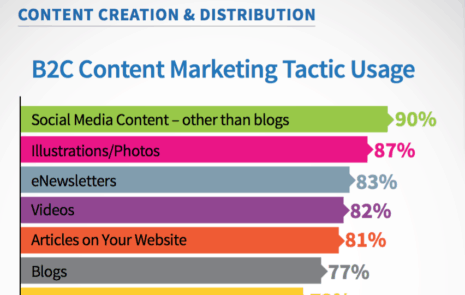
How Short Attention Spans Confound Content Marketing
Here’s the problem: American attention spans are now as short as 8 seconds. Even a goldfish can focus for 9 seconds.
Marketers must be able to tell their story in only 7 seconds … in a media sound bite, headline, Tweet, or elevator speech.
How Short Attention Spans Confound Content Marketing
Imagine, it’s time to present the content marketing plan. Put yourself in your executives’ shoes for a minute.
How many PowerPoint slides do you think they see? Many see 1,000 or more PowerPoint slides in a week.
Unfortunately, that volume of PowerPoint can undermine your ability to position content marketing with executives. To adjust to shorter attention spans, forget about the song and dance of PowerPoint.
Why? Because PowerPoint does not invite deep thought. It places an audience into a passive role, like watching TV. It serves up eye candy, invites superficial skimming, and disappears in a flash.
After seeing a parade of slides, how much does your audience retain? Do they get the point? Are they ready to make a decision – or do they ask to see more PowerPoint?
Focus on the power of one page.
Recently I reviewed 3 one-page plans. Unlike the PowerPoints, I recall almost every bit.
I’m grateful to a former boss and mentor, Dick Notebaert, for teaching me the discipline of one-page plans. As CEO at Ameritech and Tellabs, he expected me to organize my thoughts on any given critical topics — and fit a plan onto one side of one piece of paper.
With a one-page plan, my CEO and I could focus fully on the real issues. He would challenge my thinking, down to each exact word. Our discussions were brief and robust. With a one-page plan in hand, we could reach a decision quickly (unlike a roomful of people just waking up after a long PowerPoint).
Boiling your strategy down to one page is hard. But it works like magic when you need to get and keep executives’ attention.
For companies like Ameritech, RR Donnelley and Tellabs, I built one-page plans around 4 pillars:
1.) Objectives: What does the company need to accomplish? Include business, customer and financial goals.
2.) Goals: How will the company measure that? Include how many customers, units sold, revenue and profit.
3.) Strategies: What will the department or program do to meet the company objective? If it does not address the needs in points 1 and 2, it’s the wrong strategy.
4.) Metrics: How will we measure the success of those strategies? Focus on key measures in addition to the business measures in point 2.
Note that 1 and 2 reflect your understanding and alignment with business needs. Points 3 and 4 guide marketing operations. Points 1 and 3 specify what to do, while 2 and 4 focus on how to measure success.
One-page plans make expectations crystal-clear for a boss or a client. A one-page plan helps align everyone who’s working on a program or project, internal or external.
Unlike a marketing plan that’s fills a binder and parks on a bookshelf, one-page plans provide a ready guide for day-to-day work.
A one-page plan explains exactly what you’re going to do, what resources you need, and how it will make a difference for the company. When you have only seconds to make your point stick, one-page plans are key.
Contact Us
Related Posts
Top 100 Content Marketing Question: How can content subtly sell content marketing?
To subtly sell content marketing: Know your customers’ tribe. Learn everything about your tribe’s passion. Make content that feeds your tribe’s passion. Your tribe...
“Is there a recommended number of tactics to share content, so it’s not spread too thin?”
Let’s not spread ourselves too thin as we do content marketing. Instead, we can figure out how to do fewer things and achieve better results. Here’s how. Marketers are learning:...
Top 100 Content Marketing Question: “How do you escalate strategies and goals up to decision-makers?”
A marketer from Kaiser Permanente asked, “How do you best escalate strategies and goals up to decision-makers?” It’s among the Top 100 Questions on...
5 Ways to Become Customers’ Partner with Content Marketing
Brands that walk side by side with customers show up as partners. Content marketing can go a long way towards proving that you’ll be...





